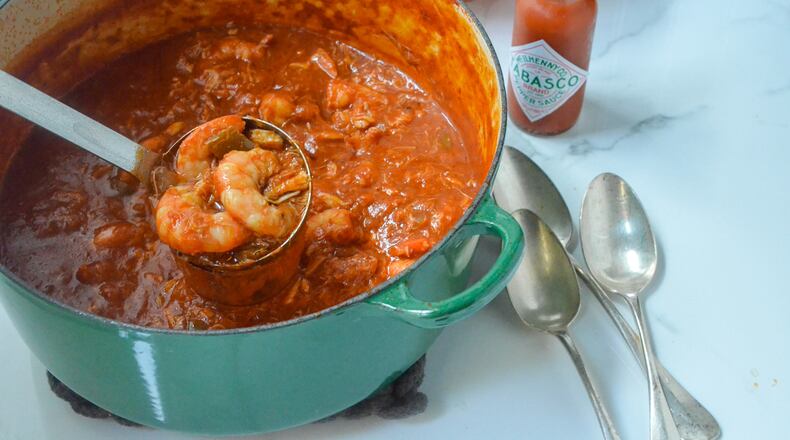This recipe for Mama’s Seafood Gumbo has been a part of my life since childhood. It is one of the original recipes in my first cookbook, “Bon Appetit, Y’all: Recipes and Stories from Three Generations of Southern Cooking” (Ten Speed, 2008). I’ve recently revised and updated the cookbook, adding new recipes and reducing calories in many of the heritage recipes, but this family standby has remained unchanged.
It’s simple coastal cooking, using only a handful of ingredients: roux, vegetables, shrimp stock, tomato paste and fresh high-protein, low-in-fat, seafood. It’s naturally good and good for you without any additions or recipe remakes.
You may be accustomed to a mélange of ingredients with gumbo. Much of that has to do with Creole vs. Cajun styles of cooking. Both styles start with a roux and might include okra or file powder. File powder is made from the dried leaves of the sassafras tree and imparts a mild, lemon flavor. Cajun seafood gumbo also usually includes chicken or sausage, while Creole gumbo, like this one, primarily uses shellfish and tomato. There’s also no spice blend for seasoning in this recipe; hot sauce offers up a clean kick.
Mama’s Seafood Gumbo is a fantastic example of how the new “Bon Appetit, Y’all: Recipes and Stories of Three Generations of Southern Cooking, Revised and Updated, with New Recipes” (UGA Press, $24.95) is still my story and how I eat in real life, a Mediterranean diet with a Southern accent. It’s a great, slow-cooking weekend recipe for a crowd to enjoy as the weather cools.
AUTHOR APPEARANCE
7:30 p.m., Oct. 15, $6 members, $12 nonmembers. Virginia Willis in Conversation with Cynthia Graubart. Book signing for “Bon Appetit, Y’all: Recipes and Stories From Three Generations of Southern Cooking, Revised and Updated, with New Recipes” to follow. Atlanta History Center, 130 W. Paces Ferry Rd NW, Atlanta, 404-814-4000. Register online at atlantahistorycenter.com/event/virginia-willis.
Mama’s Seafood Gumbo
When peeling the shrimp, save the shells to make a quick shrimp stock. While your roux cooks, place the shells in a pot and add 5 cups of water. (If you want to boost the flavor more, add a few fresh bay leaves, sprigs of parsley and thyme, a quartered onion, chopped carrot and chopped celery.) Bring to a boil, then decrease the heat to low and simmer until fragrant and flavorful, about 30 minutes. Strain the stock, discarding the solids.
2 tablespoons unsalted butter
3 tablespoons all-purpose flour
1 onion, preferably Vidalia, chopped
1 green bell pepper, cored, seeded and chopped
4 cups shrimp stock or water
2 (6-ounce) cans tomato paste
1 teaspoon coarse kosher salt, plus more to taste
½ teaspoon freshly ground black pepper, plus more to taste
2 pounds large shrimp (21/25 count), peeled and deveined
1 pound crabmeat, picked over for cartilage
Hot sauce, to taste
1/4 teaspoon file powder, optional
In a heavy-bottomed pot or Dutch oven, melt the butter over medium heat. Add the flour, stirring often, and cook to a medium-brown roux, about 30 minutes.
Add the onion and bell pepper and stir to combine. Cook until the vegetables have wilted and are lightly golden, about 5 minutes. Add the stock and tomato paste and stir to combine. Season with salt and pepper. Bring to a boil over high heat, then decrease the heat to low and cover. Simmer, stirring occasionally, until flavorful and thickened, 1 1/2 to 2 hours.
Add the shrimp and crabmeat and stir to combine. Continue cooking over very low heat until the shrimp are cooked through, an additional 10 minutes. Season with hot sauce and file powder. Taste and adjust for seasoning with salt and pepper.
Serves 8.
Per serving: 227 calories (percent of calories from fat, 19), 29 grams protein, 18 grams carbohydrates, 9 grams total sugars, 3 grams fiber, 5 grams total fat (2 grams saturated), 206 milligrams cholesterol, 1,049 milligrams sodium.
Reprinted with permission from “Bon Appetit, Y’all: Recipes and Stories of Three Generations of Southern Cooking, Revised and Updated, with New Recipes” by Virginia Willis, copyright (c) 2024. Published by University of Georgia Press.
Sign up for the AJC Food and Dining Newsletter
Read more stories like this by liking Atlanta Restaurant Scene on Facebook, following @ATLDiningNews on X and @ajcdining on Instagram.
About the Author
Keep Reading
The Latest
Featured


